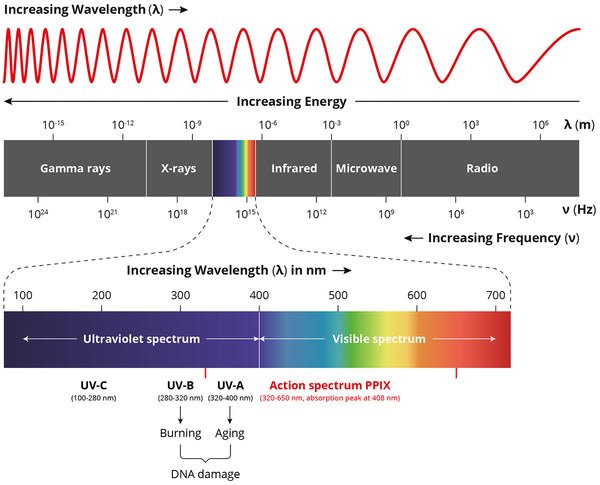What Is Red and Near Infrared (NIR) Light Therapy & What are the Benefits?
I am so excited to add a Mito Red Light to our Detox Center. I have personally used Mito Red Lights for many years and I am excited to offer it to my clients.
If you want to buy your own you can click here and use the discount code: WELLMINDBODY.
Benefits of Red and Near Infrared Light Therapy
Red and near infrared light has been shown to have positive effects on cell function in animal and human studies and aid in improving a wide range of conditions.
Benefits of red and near infrared light therapy include (Cleveland Clinic, 2022):
Promotes wound healing and tissue repair
Supports collagen production / anti-aging
Reduces swelling and inflammation (pain)
Improves joint health
Improves physical performance, muscle recovery and energy levels
Increases melatonin / improves sleep
Red and near infrared light are part of the electromagnetic spectrum, and more specifically, part of the spectrum of light emitted by the sun. These wavelengths of light are “bioactive” in humans.
Research has shown that mitochondrial photostimulation can increase ATP production and cause transient increases in reactive oxygen species (ROS) (Tafur & Mills, 2008).
Near Infrared Light (NIR) for Depression and Anxiety
Schiffer et al., (2009) examined how NIR treatment could:
1. Improve the psychological status of patients
2. Show a relationship between immediate psychological improvements when hemispheric emotional valence (HEV) was taken into account
3. Show an increase in frontal pole regional cerebral blood flow (rCBF)
4. Be applied without side effects
The results of the study indicated that 2-weeks post treatment of NIR, 6 of 10 patients had a remission score on the Hamilton Depression Rating Scale (HAM-D) and 7 of 10 achieved this on the Hamilton Anxiety Rating Scale (HAM-A). Patients experienced highly significant reductions in both HAM-D and HAM-A scores following treatment, with the greatest reductions occurring at 2 weeks. No side effects were found. The results also indicated that immediately after treatment, the Positive and Negative Affect Scale (PANAS) scores improved significantly (Schiffer et al., 2009).
Near Infrared Light for Stroke and Traumatic Brain Injury (TBI)
Near infrared (NIR) light has been shown to be beneficial in animal models for stroke, spinal cord injury, optic nerve injury, TBI, and in human trials for stroke and TBI (Henderson et al., 2015)
FDA and Red Light Therapy
Near infrared (NIR) and red light therapy devices have been FDA-approved for several purposes so far, including hair-loss reversal, anti-aging, acne, wound healing, pain relief, fat loss, and more.
Wavelengths of Light
Most wavelengths of light (UV, blue, green, yellow, etc.) are unable to penetrate into the body - instead they stay in the layers of the skin.
However, as the picture below shows, red and near infrared light are able to penetrate deeper into the human body and are able to reach the cells, tissues, blood, nerves, into the bones and even into the brain.
Below is a chart outlining the electromagnetic spectrum:
Electromagnetic waves range from 0.0001 nanometers (gamma waves) all the way to over meters (radio waves).
If you remember high school physics, when you pass white light through a prism it separates out the different colors based on their wavelengths (ROYGBIV). Only a tiny part of this spectrum (roughly 400nm to 700nm) is actually visible to the human eye.
Red light between 600-700nm offer benefits for skin texture and tone, smoothing fine lines and wrinkles, promoting collagen production and generally rejuvenating the appearance of skin and hair.
Near infrared light (NIR) 700nm - 1100nm penetrates deeper into the tissues to assist with wound healing, muscle recovery, nerve injury and joint pain.
How does Red Light Therapy Work?
Red light can help boost cellular energy production.
The most well studied mechanism of action surrounding red and near infrared light therapy is increased mitochondrial energy production in the cells. Mitochondria are tiny organelles that are the energy power plants of all the cells in our body. Red and near infrared light therapy helps the mitochondria create more of that energy.
The specific photons found in red and near infrared light interact with a photoreceptors within our cells called cytochrome c oxidase. This interaction stimulates the mitochondria in our cells to use oxygen more efficiently, which allows the mitochondria to produce more ATP (adenosine triphosphate). Adenosine triphosphate is a complex organic chemical that provides energy to drive many processes in living cells, e.g. muscle contraction, nerve impulse propagation, and chemical synthesis. Found in all forms of life, ATP is often referred to as the "molecular unit of currency" of intracellular energy transfer. When our cells have more energy, they simply perform better.
It is not surprising that red and near infrared light deliver such a myriad of benefits. Our ancestors spent many hours outdoors receiving these beneficial wavelengths of light from the sun. Modern humans with our homes, transport and office spaces are extremely "mal-illuminated".
Mito Red Light devices deliver clinically relevant doses of these beneficial wavelengths of light allowing you to conveniently "supplement" red light therapy at home on your own schedule.
I hope this information helps!
References:
Henderson, T. A., Morries, L., & Cassano, P. (2015). Treatments for traumatic brain injury with emphasis on transcranial near-infrared laser phototherapy. Neuropsychiatric Disease and Treatment, 2159. https://doi.org/10.2147/NDT.S65809
Red Light Therapy. (2022). Cleveland Clinic. https://my.clevelandclinic.org/health/articles/22114-red-light-therapy
Schiffer, F., Johnston, A. L., Ravichandran, C., Polcari, A., Teicher, M. H., Webb, R. H., & Hamblin, M. R. (2009). Psychological benefits 2 and 4 weeks after a single treatment with near infrared light to the forehead: A pilot study of 10 patients with major depression and anxiety. Behavioral and Brain Functions, 5(1), 46. https://doi.org/10.1186/1744-9081-5-46
Tafur, J., & Mills, P. J. (2008). Low-Intensity Light Therapy: Exploring the Role of Redox Mechanisms. Photomedicine and Laser Surgery, 26(4), 323–328. https://doi.org/10.1089/pho.2007.2184




